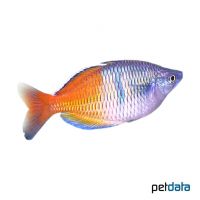Boeseman's Rainbowfish (Melanotaenia boesemani)
| Boeseman's Rainbowfish Melanotaenia boesemani | |
|---|---|
| Name | Boeseman's Rainbowfish |
| Name Lat. | Melanotaenia boesemani |
| Family | Rainbowfishes |
| Family lat. | Melanotaeniidae |
| Order | Silversides |
| Order lat. | Atheriniformes |
| Origin | New Guinea |
| Habitat | Lakes |
| Diet | Omnivore |
| pH | 6.5-8.0 |
| Behavior | Peaceful |
| Keeping | Group |
| Care Level | Moderate |
| Reproduction | Egg scatterer |
| Breeding | Moderately difficult |
| Life Span | 4-5 years |
| Protection | No |
| Metric Units | |
| Size | 9 cm |
| Temperature | 23-27 °C |
| Hardness | 5-15 °dH |
| Aquarium | 110 l |
| US Units | |
| Size | 3.5" |
| Temperature | 73-81 °F |
| Hardness | 89-267 ppm |
| Aquarium | 30 gal |
Distribution and habitat
The distribution area of the Boesemans Rainbowfish is the Ayamaru Lakes in West Papua on New Guinea. There they are found in the interconnected lakes Ayamaru, Hain and Aytinjo, where they live in shallow, clear water with dense aquatic vegetation.
Maintenance
The aquarium should have a dense background and edge planting, with hiding places (roots, stones) and plenty of free swimming space. A fine sandy substrate, bright light and clear, medium hard water is ideal
No ammonia, ammonium and nitrite should be detectable, the nitrate value should not exceed 100 mg/l. To ensure the water quality and oxygen content, a filter and heater adapted to the aquarium size is required, as well as lighting for the species-appropriate day-night rhythm of the animals.
Diet
The food supply consists of live food, such as cyclops, daphnia, mysis, artemia and mosquito larvae, which is also accepted without problems in frozen form, supplemented with commercially available frozen special food mixtures. They also need some vegetable food, such as algae leaves, pureed leafy and wild vegetables or dry food (flakes, granules, pellets) with vegetable components (spirulina, kelp)
It is recommended to feed small portions several times a day. A regular and varied diet promotes health and increases resistance. Only as much should be fed as is eaten immediately (in a maximum of 10 minutes).
Behaviour and compatibility
They are lively and swimming fish, which show their most beautiful coloration in the shoal. At least 5, but preferably many more Boesemans Rainbowfish should be kept together. In too small groups they are often quarrelsome. They can be well socialized with rainbowfish of similar size, but also with other fish.
Basically, only compatible fish species with similar water condition and water temperature requirements should be socialized.
Sex dimorphism
The male is much more colorful than the slightly smaller female.
Reproduction and breeding
They are free spawners, which during the reproductive period daily in the morning (morning sun) deposit their eggs with adhesive filaments in fine-leaved plants. The fry hatch after 6-7 days. The parents do not engage in brood care.
Fry must be fed several times a day with special rearing food (dust food, infusoria). In community tanks breeding is hardly possible, because the spawn is easy prey.
Important
They like to jump, so the aquarium should be well covered.
The well-being of the fish should be checked regularly. The temperature should be checked daily, the pH, hardness and nitrate value should be checked at least every 14 days. Regular partial water changes are recommended, even if the contaminant level has not yet reached the upper limit. Sudden changes in water quality should be avoided. Newly introduced fish must be accustomed slowly to the water in the aquarium.
Further literature can be found in your pet store.
References
Text: Werner Winter; Image: petdata
Source: BMELV (1998): Tierschutzgutachten - Haltung von Zierfischen (Süßwasser); BAENSCH & RIEHL (2004): Aquarien Atlas Bd. 2, Mergus Verlag; ENGELMANN (2005): Zootierhaltung - Tiere in menschlicher Obhut: Fische, Verlag Harri Deutsch
- Gemäß § 21 Abs. 5 Tierschutzgesetz idgF
